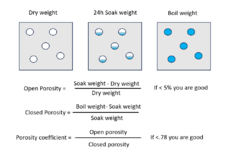The gold standard for freeze resistance in ceramics is described here: https://digitalfire.com/article/outdoor+weather+resistant+ceramics
Here is a simple version for us bonsai folk. You can test this yourself at home.
Your pot will fit into one of these groups:
1. The open porosity is <5%. This means it simply wont absorb more than 5% water. So when it freezes there is not enough water in it to burst the pot = frost resistant.
2a. The open porosity is >5% and the porosity coefficient is >0.78. This means the freezing water has nowhere to expand into and the pot will crack when it freezes.
2b. The open porosity is >5% but the porosity coefficient is <0.78. This means there is enough open space in the pores for water to expand into and the pot will not crack when it freezes. I suspect some longer lasting terracotta pots must fit in this group

Here is a simple version for us bonsai folk. You can test this yourself at home.
Your pot will fit into one of these groups:
1. The open porosity is <5%. This means it simply wont absorb more than 5% water. So when it freezes there is not enough water in it to burst the pot = frost resistant.
2a. The open porosity is >5% and the porosity coefficient is >0.78. This means the freezing water has nowhere to expand into and the pot will crack when it freezes.
2b. The open porosity is >5% but the porosity coefficient is <0.78. This means there is enough open space in the pores for water to expand into and the pot will not crack when it freezes. I suspect some longer lasting terracotta pots must fit in this group

Last edited:
